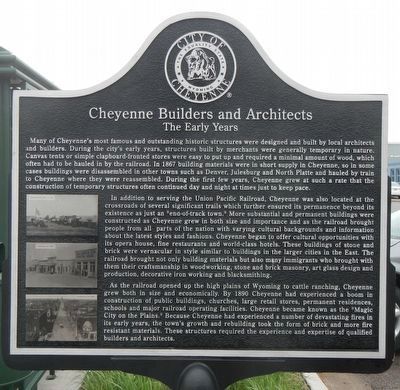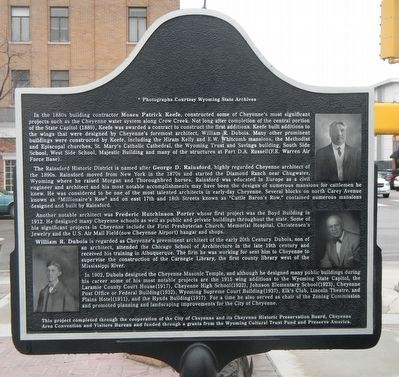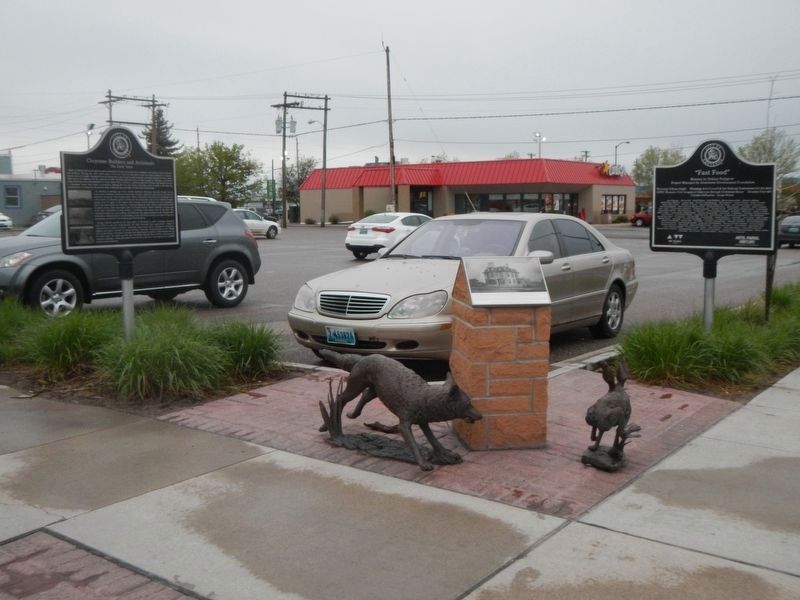Cheyenne in Laramie County, Wyoming — The American West (Mountains)
Cheyenne Builders and Architects
The Early Years
Inscription.
Many of Cheyenne's most famous and outstanding historic structures were designed and built by local architects and builders. During the city's early years, structures built by merchants were generally temporary in nature. Canvas tents or simple clapboard-fronted stores were easy to put up and required a minimal amount of wood, which often has to be hauled in by railroad. In 1867 building materials were in short supply in Cheyenne, so in some cases building were disassembled in other towns such as Denver, Julesburg and North Platte and hauled by train to Cheyenne where they were reassembled. During the first few years, Cheyenne grew at such a rate that the construction of temporary structures often continued day and night at times just to keep pace.
In addition to serving the Union Pacific Railroad, Cheyenne was also located at the crossroads of several significant trails which further ensured its permanence beyond its existence as just an "end-of-track town." More substantial and permanent building were constructed as Cheyenne grew in both size and importance and as the railroad brought people from all parts of the nation with varying cultural backgrounds and information about the latest styles and fashions. Cheyenne began to offer cultural opportunities with its opera house, fine restaurants and world-class hotels. These buildings of stone and brick were vernacular in style similar to buildings in the larger cities of the East. The railroad brought not only buildings materials but also many immigrants who brought with them their craftsmanship in woodworking, stone and brick masonry, art glass design and production, decorative iron working and blacksmithing.
As the railroad opened up the high plains of Wyoming to cattle ranching, Cheyenne grew both in size and economically. By 1890 Cheyenne has experienced a boom in construction of public buildings, churches, large retail stores, permanent residences, schools and major railroad operating facilities. Cheyenne became known as the "Magic City on the Plains." Because Cheyenne had experienced a number of devastating fires in its early years, the town's growth and rebuilding took the form of brick and more fire resistant materials. These structures required the experience and expertise of qualified builders and architects.
In the 1880s building contractor Moses Patrick Keefe, constructed some of Cheyenne's most significant projects such as the Cheyenne water system along Crow Creek. Not long after completion of the central portion of the State Capitol (1889), Keefe was awarded a contract to construct the first additions. Keefe built additions to the wings that were designed by Cheyenne's foremost architect, William R. Dubois. Many other prominent
buildings were constructed by Keefe, including the Hiram Kelly and E.W. Whitcomb mansions, the Methodist and Episcopal churches, St. Mary's Catholic Cathedral, the Wyoming Trust and Savings building, South Side School, West Side School, Majestic Building and many of the structures at Fort D.A. Russell (F.E. Warren Air Force Base).
The Rainsford Historic District is named after George D. Rainsford, highly regarded Cheyenne architect of the 1890s. Rainsford moved from New York in the 1870s and started the Diamond Ranch near Chugwater, Wyoming where he raised Morgan and Thoroughbred horses. Rainsford was educated in Europe as a civil engineer and architect and his most notable accomplishments may have been the designs of numerous mansions for cattlemen he knew. He was considered to be one of the most talented architects in early-day Cheyenne. Several blocks on north Carey Avenue known as "Millionaire's Row" and on east 17h and 18th Streets known as "Cattle Baron's Row," contained numerous mansions designed and built by Rainsford.
Another notable architect was Frederic Hutchinson Porter whose first project was the Boyd Building in 1912, He designed many Cheyenne schools as well as public and private buildings throughout the state. Some of his significant projects in Cheyenne include the First Presbyterian Church, Memorial Hospital, Christensen's Jewelry and
the U.S. Air Mail Field (now Cheyenne Airport) hangar and shops.
William R. Dubois is regarded as Cheyenne's preeminent architect of the early 20th Century. Dubois, son of an architect, attended the Chicago School of Architecture in the late 19th century and received his training in Albuquerque. The firm he was working for sent him to Cheyenne to supervise the construction of the Carnegie Library, the first county library west of the Mississippi River.
In 1902, Dubois designed the Cheyenne Masonic Temple, and although he designed many public buildings during his career some of his most notable projects are the 1915 wing additions to the Wyoming State Capitol, the Laramie County Court House (1917), Cheyenne High School (1922), Johnson Elementary School (1923), Cheyenne Post Office or Federal Building (1932), Wyoming Supreme Court Building (1937), Elk's Club, Lincoln Theatre, and Plains Hotel (1911), and the Hynds Building (1917) For a time he also served as chair of the Zoning Commission and promoted planning and landscape improvements of the City of Cheyenne.
Erected by City of Cheyenne, Cheyenne Historic Historic Preservation Board, Cheyenne Area Convention and Visitors Board, Wyoming Cultural Trust Fund and Preserve America.
Topics. This historical marker is listed in this topic list: Architecture.
Location. 41° 8.065′ N, 104° 48.804′ W. Marker is in Cheyenne, Wyoming, in Laramie County. Marker is at the intersection of Warren Avenue and East 17th Street, on the right when traveling north on Warren Avenue. Touch for map. Marker is at or near this postal address: 1621 Warren Avenue, Cheyenne WY 82001, United States of America. Touch for directions.
Other nearby markers. At least 8 other markers are within walking distance of this marker. The Cheyenne Club (here, next to this marker); a different marker also named The Cheyenne Club (within shouting distance of this marker); Historic Plains Hotel (about 500 feet away, measured in a direct line); First United Methodist Church (about 600 feet away); The Burlington Routes (about 700 feet away); The Cheyenne Opera House and Territorial Library (about 800 feet away); 1974 Downtown National Historic District (approx. 0.2 miles away); The Trolleys / Cheyenne's Street Railway (approx. 0.2 miles away). Touch for a list and map of all markers in Cheyenne.
Also see . . .
1. George D. Rainsford - LivingPlaces. An equestrian at heart, Rainsford startled the eastern horse world at Madison Square Garden in 1883 when a horse bred at the Diamond, Spartan, took the stallion prize. The Wyoming breeding venture, apparently financed by his parents, brought international fame to the Diamond Ranch and the pure bred Morgans fathered by Spartan. (Submitted on June 30, 2016, by Barry Swackhamer of Brentwood, California.)
2. Frederic Hutchinson Porter - LivingPlaces. In 1906, "Bunk" Porter began an apprenticeship in the Denver Architect's Office. He came to Cheyenne in 1911 as an inspector for the construction of the Boyd Building (at that time the Citizen's National Bank). ... traveled throughout Europe. He then returned to Cheyenne and established the architectural firm of Baerresen and Porter; within two years he had set up an independent practice. (Submitted on June 30, 2016, by Barry Swackhamer of Brentwood, California.)
3. Dubois, William (1879-1953) - Encyclopedia of the Great Plains. William Robert Dubois was the most prolific designer of public, commercial, and residential buildings in Wyoming during the first half of the twentieth century. His architectural legacy is still evident throughout the Cowboy State. Dubois also designed buildings in Nebraska, Colorado, and South Dakota. (Submitted on June 30, 2016, by Barry Swackhamer of Brentwood, California.)
Credits. This page was last revised on September 26, 2020. It was originally submitted on June 30, 2016, by Barry Swackhamer of Brentwood, California. This page has been viewed 558 times since then and 50 times this year. Photos: 1, 2, 3. submitted on June 30, 2016, by Barry Swackhamer of Brentwood, California.


